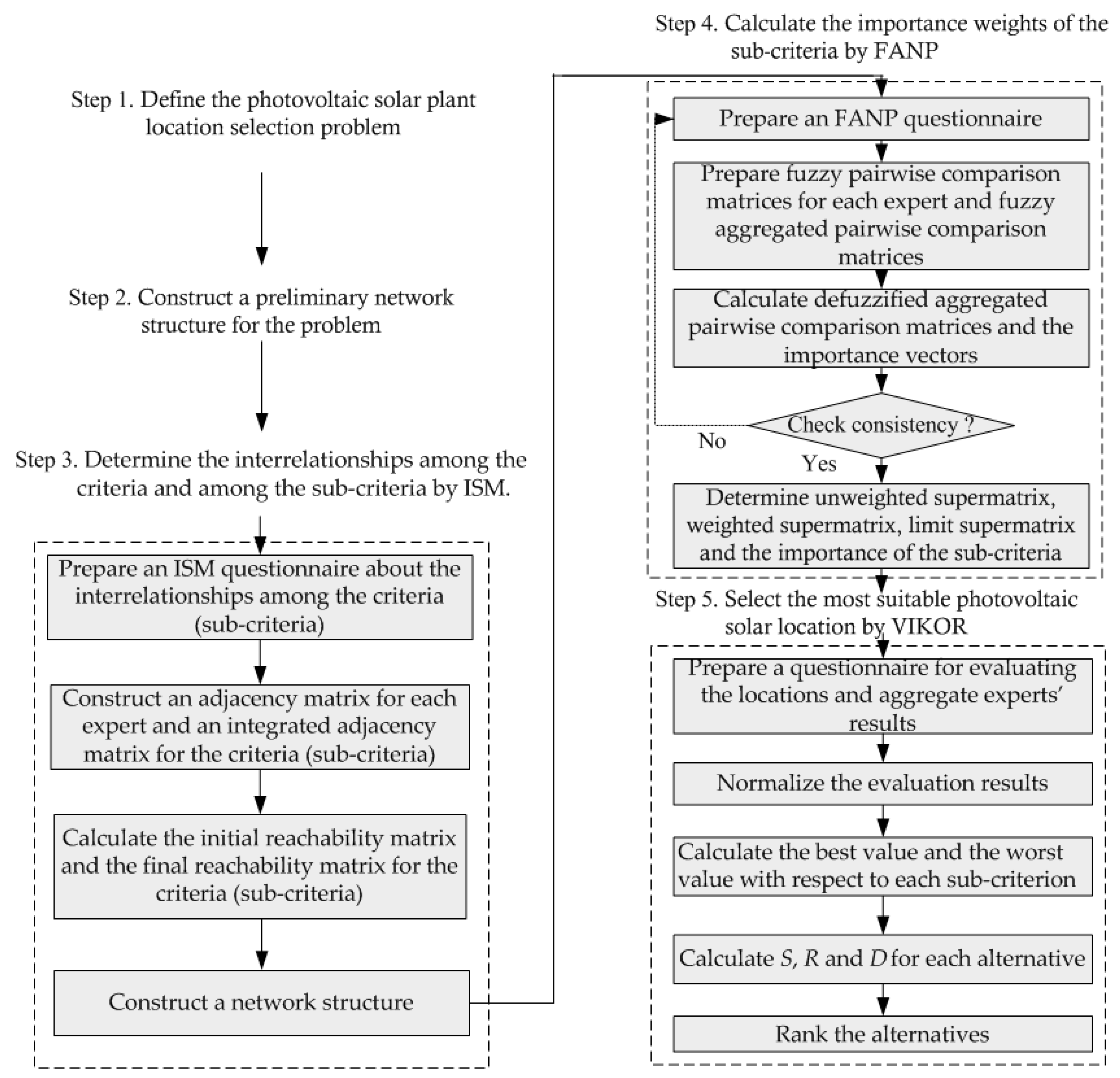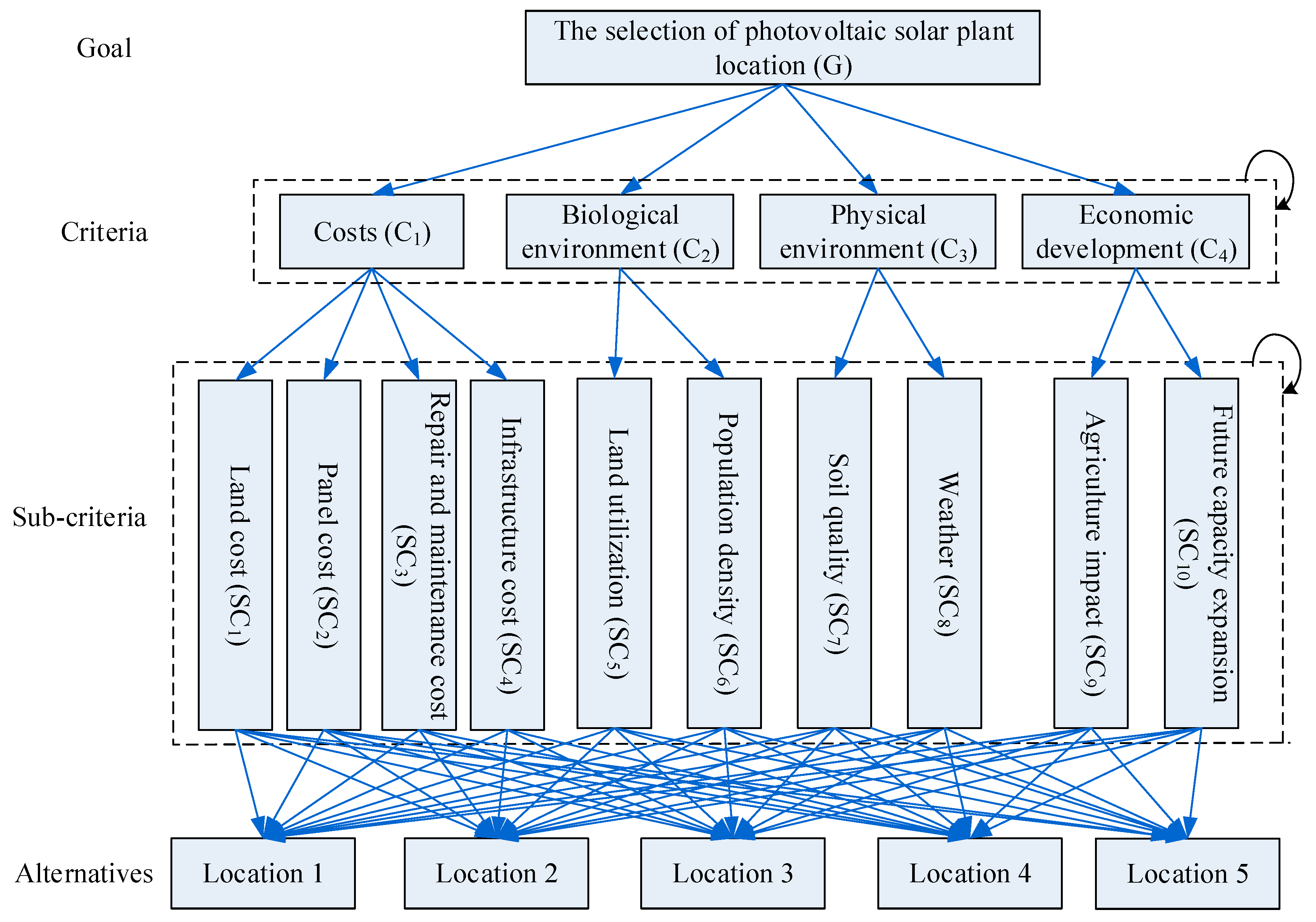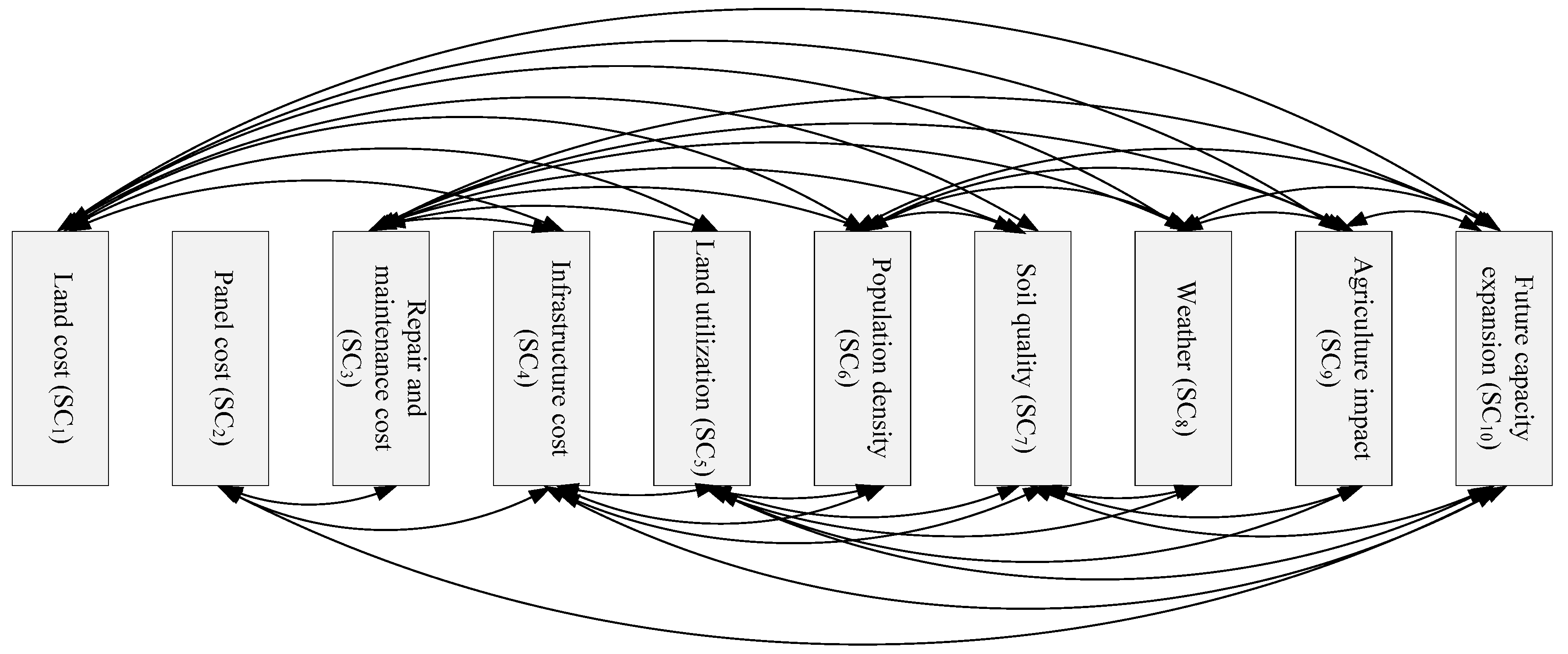1. Introduction
Climate changes and environmental pollution have caught the attention of many developing and developed counties to replace fossil fuel energy with renewable energy. After a certain kind of renewable energy is preferred and selected, a suitable plant location must be selected. In short, the renewable energy location selection problem is one of the most important tasks in developing renewable energy plants.
More and more scholars have contributed in developing models for solving the renewable energy location selection problem. Some recent works are reviewed here. Yeh and Huang [
1] proposed a model to understand the importance of various factors in evaluating wind farm locations by integrating goal/question/metric (GQM) method, fuzzy decision-making trial and evaluation laboratory (DEMATEL), and analytic network process (ANP). The GQM method was applied to classify factors into different dimensions, and the DEMATEL was used to find the correlations among the dimensions. The ANP was then adopted to obtain the relative weights of the criteria. Kang et al. [
2] constructed an approach by integrating the fuzzy ANP (FANP) and benefits-opportunities-costs-risks (BOCR) to facilitate the decision making of wind farm site selection. Tahri et al. [
3] proposed the use of geographic information system (GIS) and analytic hierarchy process (AHP) to evaluate solar farm locations. The AHP was adopted to calculate the weights of four criteria: location, orography, land use and climate. The GIS was used to collect the data of these criteria in different locations. A case study was carried out to assess the suitability of a set of locations in southern Morocco. Chang [
4] constructed a multi-choice goal programming model for devising an optimal mix of different renewable energy plant types in different locations while considering various criteria. The model could help decision makers determine appropriate weights to the factors, and find the optimal solution in the renewable energy capacity expansion planning problem. Lee et al. [
5] constructed a two-stage framework for evaluating renewable energy plant site alternatives. In the first stage, fuzzy AHP (FAHP) was applied to set the assurance region (AR) of the quantitative factors. By incorporating the AR into data envelopment analysis (DEA), the efficiencies of a number of plant site candidates could be generated, and several sites were selected for further analysis. In the second stage, the FAHP was applied to select the most appropriate site by considering qualitative characteristics of the sites. Ribeiro et al. [
6] studied the electric energy generation from small-scale solar and wind power, and listed three attributes, namely, location, area and shape, as having a great influence on power generation. A comparison method was applied in a case study in Brazil. Aragonés-Beltrán et al. [
7] proposed two multiple-criteria decision-making models to evaluate photovoltaic solar power plant investment projects by considering six categories of risks and fifty project execution delay and/or stoppage risks. An AHP model, which considered the problem as a hierarchy, and an ANP model, which considered the problem as a network, were constructed to select the plant which minimized the overall risk. Sánchez-Lozano et al. [
8] presented a framework, which integrated GIS, AHP and TOPSIS, to the optimal placement of photovoltaic solar power plants. GIS was applied to reduce the geographical area of study by considering constraints and weighting criteria. The weights of the criteria were calculated by the AHP, and the ranking of the power plants was obtained by applying the TOPSIS. Aragonés-Beltrán et al. [
9] proposed a three-phase multi-criteria decision approach for selecting solar-thermal power plant investment projects. In the first phase, a project was accepted or rejected according to a set of criteria grouped as risks, costs and opportunities using an AHP model. In the second phase, the accepted projects were further assessed in risks using the AHP model. In the third phase, a ranking of the projects that were economically profitable based on project risk levels and execution time delays was prepared using both the AHP and the ANP models. Wu et al. [
10] proposed a three-stage framework of solar thermal power plant site selection. In the first stage, potential feasible sites were identified based on energy, infrastructure, land, and environmental and social factors. In the second stage, the importance weights of the criteria were calculated by fuzzy measures. In the third stage, the sites were ranking using a group decision making method with linguistic Choquet integral (LCI). Sánchez-Lozano et al. [
11] proposed a hybrid method to evaluate suitable locations for the installation of solar thermoelectric power plants. GIS was applied to limit the location alternatives, and the AHP was used to obtain the weights of the criteria. Then, the fuzzy TOPSIS was used to rank the alternatives.
A decision-making model is necessary for selecting the most suitable photovoltaic solar plant location. Therefore, this research incorporates three well-known methodologies, the interpretive structural modeling (ISM), the FANP and the VIKOR (VlseKriterijumska Optimizacija I Kompromisno Resenje in Serbian, meaning multi-criteria optimization and compromise solution), to facilitate the decision-making process. The rationale behind using the three different methodologies is to overcome the drawback of the FANP. While the ANP and the FANP have become rather popular multiple-criteria decision-making methodologies, a questionnaire is usually very lengthy if all the interrelationships among the criteria and among the sub-criteria are evaluated. In addition, the requirement of pairwise comparing the performance of each of the two alternatives with respect to each sub-criterion can be very tiresome for the person who fills out the questionnaire. Therefore, a model that integrates the ISM, the FANP and the VIKOR can overcome such problems. Since an evaluation network can be rather complex, the ISM is applied first to understand the interrelationships among the criteria and among the sub-criteria. Based on the interrelationships, the network can be constructed comprehensively. The FANP is then used to calculate the importance weights of the sub-criteria in the network. Based on the weights of the sub-criteria, the VIKOR is applied to calculate the overall performances of the photovoltaic solar plant locations.
The rest of this paper is organized as follows. In
Section 2, the methodologies are briefly introduced. In
Section 3, the proposed model, which incorporates the ISM, the FANP, and the VIKOR, is presented. In
Section 4, a case study for selecting the most suitable photovoltaic solar plant location in Taiwan is presented. In the final section, some conclusion remarks are made.
3. Proposed Model
A model that incorporates the ISM, the FANP and the VIKOR is proposed here for the selection of the most suitable location for constructing a photovoltaic solar plant. The flowchart of the model is as depicted in
Figure 1. The ISM is used to determine the interrelationships among the criteria and among the sub-criteria, and a network can be constructed based on the interrelationships. The FANP is adopted next to obtain the importance weights of the sub-criteria in the network. Using the weights of the sub-criteria from the FANP, the VIKOR is used to rank the overall performances of the photovoltaic solar plant locations.
The steps of the proposed model are as follows.
Step 1. Define the photovoltaic solar plant location selection problem. Perform a comprehensive literature review and consult experts in the field about the problem.
Step 2. Construct a preliminary network structure for the problem. Based on the literature and expert consultation, a network with criteria and sub-criteria is constructed. An example of the network is depicted in
Figure 2, and the interrelationships among the criteria and among the sub-criteria will be determined by Step 3.
Step 3. Determine the interrelationships among the criteria and among the sub-criteria by applying the ISM.
Step 3.1. Prepare an ISM questionnaire. Based on the preliminary network, the ISM questionnaire asks about the interrelationships among the criteria and among the sub-criteria. For example, the relationship between criterion 1 and criterion 2 can be from C1 to C2, from C2 to C1, in both directions between C1 and C2, or C1 and C2 are unrelated.
Step 3.2. Construct an adjacency matrix for the criteria and for the sub-criteria from each expert. For example, the adjacency matrix for the criteria from expert
k can be represented as follows:
where
denotes the relation between criteria C
i and C
j assessed by expert
k, and
= 1 if C
j is reachable from C
i; otherwise,
= 0.
Step 3.3. Construct an integrated adjacency matrix for the criteria and for the sub-criteria. For example, the adjacency matrix for the criteria is prepared by combining the adjacency matrix for the criteria from all experts using the arithmetic mean method. If the calculated value for
is greater than or equal to 0.5, we let
be 1; otherwise, let
be 0. The integrated adjacency matrix for the criteria can be represented as follows:
where
denotes the relation between criteria C
i and C
j, and
= 1 if C
j is reachable from C
i; otherwise,
= 0.
Step 3.4. Calculate the initial reachability matrix for the criteria and for the sub-criteria. The initial reachability matrix can be obtained by summing up the integrated adjacency matrix and the unit matrix. For example, the initial reachability matrix for the criteria is as follows:
Step 3.5. Calculate the final reachability matrix. A convergence can be met by using the operators of the Boolean multiplication and addition. The final reachability matrix can reflect the transitivity of the contextual relation among the criteria and among the sub-criteria. For example, the final reachability matrix for the criteria is as follows:
where
denotes the impact of criterion C
i to criterion C
j.
Step 3.6. Construct a network structure under the FANP. Based on the final reachability matrix for the criteria and for the sub-criteria, a completed network structure can be constructed.
Step 4. Calculate the importance weights of the sub-criteria by applying the FANP.
Step 4.1. Prepare an FANP questionnaire. Based on the network in
Figure 2, the FANP questionnaire asks about the importance of the criteria, the importance of the sub-criteria, the interrelationships among the criteria, and the interrelationships among the sub-criteria. Experts in the field are invited to fill out the questionnaire using pairwise comparisons based on linguistic variables, as shown in
Table 1.
Step 4.2. Prepare fuzzy pairwise comparison matrices for each expert. The questionnaire results from each expert are transformed into triangular fuzzy numbers based on
Table 1. For example, the fuzzy pairwise comparison matrix of criteria for expert
k is as follows:
where
is the pairwise comparison value between criterion
i and
j determined by expert
k.
Step 4.3. Prepare fuzzy aggregated pairwise comparison matrices. Synthesize experts’ opinions using a geometric average approach. With
K experts, the geometric average for the pairwise comparison value between criteria
i and
j is:
The fuzzy aggregated pairwise comparison matrix for the criteria is:
Step 4.4. Calculate defuzzified aggregated pairwise comparison matrices. The fuzzy aggregated pairwise comparison matrices are transformed into defuzzified aggregated pairwise comparison matrices using the center-of-gravity method.
Step 4.5. Calculate the importance vector of the criteria, importance vector of the sub-criteria, interdependence among the criteria, and interdependence among the sub-criteria. For example, the importance vector for the defuzzified aggregated pairwise comparison for the criteria is as follows [
20,
21]:
where
WC is the defuzzified aggregated comparison matrix for the criteria,
wC is the eigenvector, and
is the largest eigenvalue of
WC.
Step 4.6. Examine the consistency of each defuzzified aggregated pairwise comparison matrix. The consistency index (CI) and consistency ratio (CR) for the defuzzified aggregated comparison matrix for the criteria are calculated as follows [
20,
21]:
where RI is random index [
20,
21]. If the consistency ratio is greater than 0.1, an inconsistency is present, and the experts will be asked to revise the part of the questionnaire. The calculations will be performed again.
Step 4.7. Construct an unweighted supermatrix. Use the importance vector of the criteria, the importance vectors of the sub-criteria, the interdependence among criteria, and the interdependence among sub-criteria to form an unweighted supermatrix, as shown in
Figure 3.
Step 4.8. Construct a weighted supermatrix. The unweighted supermatrix is transformed into a weighted supermatrix to ensure column stochastic [
21,
39].
Step 4.9. Calculate the limit supermatrix and the importance of the sub-criteria. By taking powers, the weighted supermatrix can converge into a stable supermatrix, called the limit supermatrix. The final priorities (importance) of the sub-criteria are found in the sub-criteria-to-goal column of the limit supermatrix.
Step 5. Select the most suitable photovoltaic solar location (alternative) by applying the VIKOR.
Step 5.1. Prepare a questionnaire for evaluating the expected performance of each photovoltaic solar location with respect to each sub-criterion. Experts in the field are invited to fill out the questionnaire with a scale from 1 to 10.
Step 5.2. Aggregate experts’ evaluation results. The evaluation results with respect to each sub-criterion from all experts are aggregated by using the arithmetic mean method.
Step 5.3. Normalize the evaluation results. For each sub-criterion, the experts’ aggregated evaluation results are normalized as follows:
where
is the normalized evaluation result for alternative
q with respect to sub-criterion
p,
is the aggregated evaluation result for alternative
q with respect to sub-criterion
p, sub-criteria
p = 1, 2, …,
P, and alternative
q = 1, 2, …,
Q.
Step 5.4. Calculate the best value
and the worst value
with respect to each sub-criterion
p. For a sub-criterion that is a benefit, that is, the larger the better, the best value is the largest value among all values of the alternatives with respect to that sub-criterion. The worst value is the smallest value among all values of the alternatives with respect to that sub-criterion.
The opposite is applied for a cost criterion:
Step 5.5. Calculate group utility
Sq and individual regret
Rq for each alternative
q.
where
is the relative weights (importance) of sub-criteria obtained from Step 4.
Step 5.6. Calculate aggregating index
Dq for each alternative
q.
where
,
,
,
, and
v is the weight of the strategy of the majority of sub-criteria (here
v = 0.5).
Step 5.7. Rank the alternatives. Three ranking lists are prepared based on Dq, Sq, Rq, respectively. The smaller the value of Dq an alternative has, the better the expected performance the alternative has. The same applies to Sq and Rq. The ranking for Dq is qD′, qD″, qD″′, etc. For example, qD′ is the best alternative in terms of Dq, and it has the smallest Dq, D′. The ranking for Sq is qS′, qS″, qS″′, etc., and their respective Sq are S′, S″, S″′, etc. The ranking for Rq is qR′, qR″, qR″′, etc., and their respective Rq are R′, R″, R″′, etc.
Step 5.8. Determine the best alternative. The best overall alternative is qD′ if the following two conditions are both met:
Condition 1.
Acceptable advantage:
where
D′ is the value
Dq for the best alternative (
qD′) in terms of
Dq,
D″ is the value
Dq for the second best alternative (
qD″) in terms of
Dq, and
Q is the total number of alternatives. This condition implies that the difference between
D′ and
D″ is significant enough to indicate that the best alternative outperforms the second best alternative in terms of
Dq.
Condition 2.
Acceptable stability in decision making: The best alternative in terms of Dq, that is, alternative qD′, must also be the best alternative in terms of both Sq and Rq. That is, qD′, qS′ and qR′ are the same alternative.
If the above two conditions are not satisfied, there are compromise solutions:
- Situation 1.
Both alternative qD′ and qD″ are compromise solutions if only condition 2 is not met.
- Situation 2.
Alternatives
qD′,
qD″, …,
qD(H) are compromise solutions if condition 1 is not met. Alternative
qD(H) is determined by
This indicates that the performances of these alternatives are not significantly different, and as a result, they are compromise solutions.
5. Conclusions
In this research, a comprehensive multiple-criteria decision-making model is proposed by incorporating the ISM, the FANP and the VIKOR. The model applies the ISM to understand the interrelationships among the criteria and among the sub-criteria, and then uses the FANP to calculate the importance weights of the sub-criteria. Finally, the VIKOR is adopted to select the most suitable photovoltaic solar plant location. A case study in Taiwan is used to demonstrate how the model can be implemented in real practice. By integrating the three methodologies, the major shortcoming of the FANP can be solved. That is, the length of the questionnaire can be reduced substantially. The proposed model can provide decision makers a better thinking process so that they can make appropriate decisions systematically.
Based on the case study, some results are found. Among the four criteria, the most important criterion is costs, followed by physical environment. Among the ten sub-criteria, land utilization is the most important sub-criterion, followed by land cost, soil quality, and repair and maintenance cost. The evaluation of the five locations shows that location 2 outperforms others in terms of both group utility and individual regret. Location 2 also performs the best on the aggregating index, which comprises both group utility and individual regret. In consequence, location 2 should be selected for constructing the photovoltaic solar plant.
The proposed model can be adopted by practitioners in relevant decision makings. The criteria or sub-criteria can be tailored according to the circumstances of the problem, and the experts in the field can contribute their expertise in determining the relative importance of and interrelationships among the factors. The expected performances of the alternatives can either be quantitative or qualitative, and the overall ranking of the alternatives can be obtained through the model.
In the case that many potential locations are available, a screening phase may be necessary to determine the feasible locations first. An extensive study of the feasible locations will then be carried out using the proposed approach. The screening phase can be performed using some tools, such as geographical information systems (GIS) or data envelopment analysis (DEA). This can be our future research direction.

















